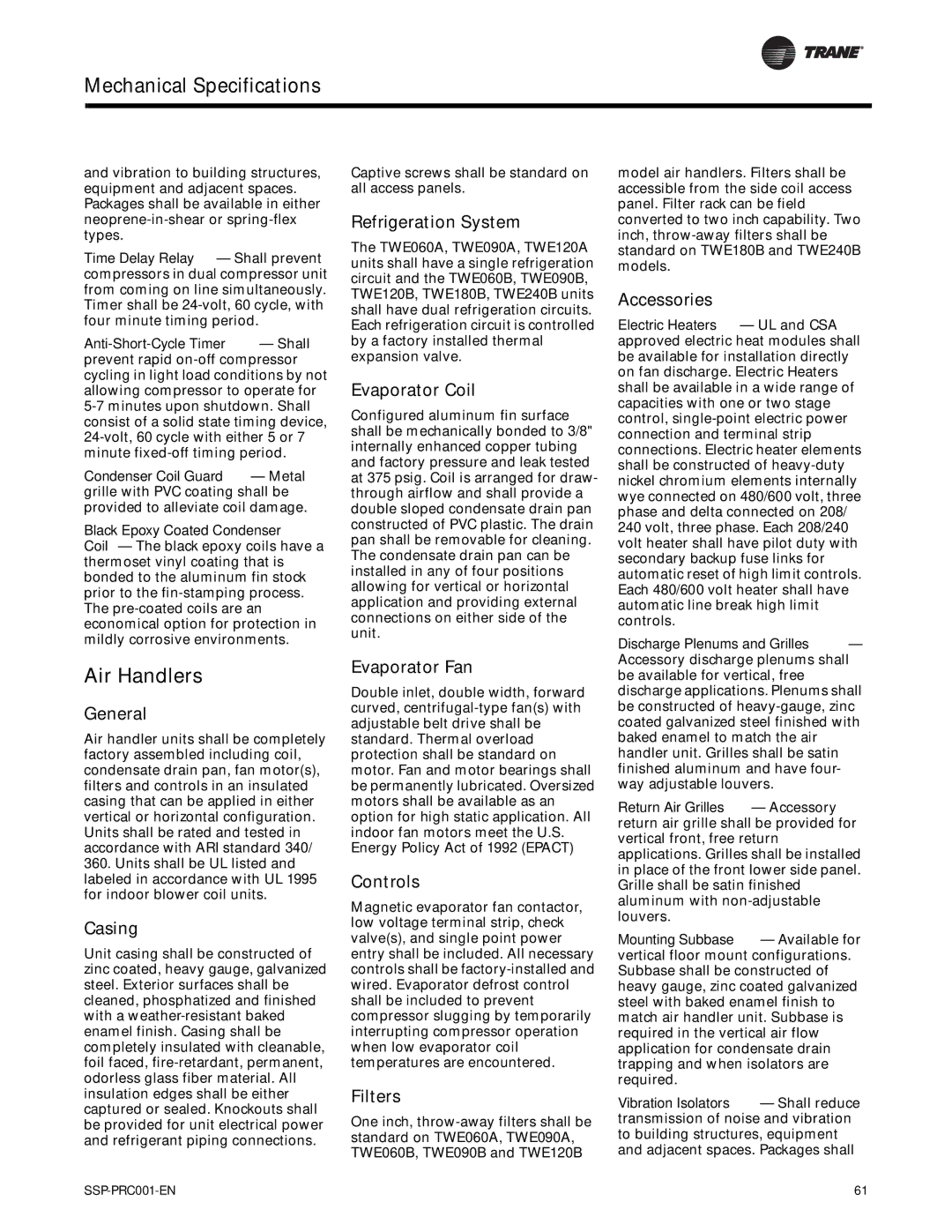and vibration to building structures, equipment and adjacent spaces. Packages shall be available in either neoprene-in-shear or spring-flex types.
Time Delay Relay — Shall prevent compressors in dual compressor unit from coming on line simultaneously. Timer shall be 24-volt, 60 cycle, with four minute timing period.
Anti-Short-Cycle Timer — Shall prevent rapid on-off compressor cycling in light load conditions by not allowing compressor to operate for 5-7 minutes upon shutdown. Shall consist of a solid state timing device, 24-volt, 60 cycle with either 5 or 7 minute fixed-off timing period.
Condenser Coil Guard — Metal grille with PVC coating shall be provided to alleviate coil damage.
Black Epoxy Coated Condenser Coil — The black epoxy coils have a thermoset vinyl coating that is bonded to the aluminum fin stock prior to the fin-stamping process. The pre-coated coils are an economical option for protection in mildly corrosive environments.
Air Handlers
General
Air handler units shall be completely factory assembled including coil, condensate drain pan, fan motor(s), filters and controls in an insulated casing that can be applied in either vertical or horizontal configuration. Units shall be rated and tested in accordance with ARI standard 340/
360.Units shall be UL listed and labeled in accordance with UL 1995 for indoor blower coil units.
Casing
Unit casing shall be constructed of zinc coated, heavy gauge, galvanized steel. Exterior surfaces shall be cleaned, phosphatized and finished with a weather-resistant baked enamel finish. Casing shall be completely insulated with cleanable, foil faced, fire-retardant, permanent, odorless glass fiber material. All insulation edges shall be either captured or sealed. Knockouts shall be provided for unit electrical power and refrigerant piping connections.
Captive screws shall be standard on all access panels.
Refrigeration System
The TWE060A, TWE090A, TWE120A units shall have a single refrigeration circuit and the TWE060B, TWE090B, TWE120B, TWE180B, TWE240B units shall have dual refrigeration circuits. Each refrigeration circuit is controlled by a factory installed thermal expansion valve.
Evaporator Coil
Configured aluminum fin surface shall be mechanically bonded to 3/8" internally enhanced copper tubing and factory pressure and leak tested at 375 psig. Coil is arranged for draw- through airflow and shall provide a double sloped condensate drain pan constructed of PVC plastic. The drain pan shall be removable for cleaning. The condensate drain pan can be installed in any of four positions allowing for vertical or horizontal application and providing external connections on either side of the unit.
Evaporator Fan
Double inlet, double width, forward curved, centrifugal-type fan(s) with adjustable belt drive shall be standard. Thermal overload protection shall be standard on motor. Fan and motor bearings shall be permanently lubricated. Oversized motors shall be available as an option for high static application. All indoor fan motors meet the U.S. Energy Policy Act of 1992 (EPACT)
Controls
Magnetic evaporator fan contactor, low voltage terminal strip, check valve(s), and single point power entry shall be included. All necessary controls shall be factory-installed and wired. Evaporator defrost control shall be included to prevent compressor slugging by temporarily interrupting compressor operation when low evaporator coil temperatures are encountered.
Filters
One inch, throw-away filters shall be standard on TWE060A, TWE090A, TWE060B, TWE090B and TWE120B
model air handlers. Filters shall be accessible from the side coil access panel. Filter rack can be field converted to two inch capability. Two inch, throw-away filters shall be standard on TWE180B and TWE240B models.
Accessories
Electric Heaters — UL and CSA approved electric heat modules shall be available for installation directly on fan discharge. Electric Heaters shall be available in a wide range of capacities with one or two stage control, single-point electric power connection and terminal strip connections. Electric heater elements shall be constructed of heavy-duty nickel chromium elements internally wye connected on 480/600 volt, three phase and delta connected on 208/ 240 volt, three phase. Each 208/240 volt heater shall have pilot duty with secondary backup fuse links for automatic reset of high limit controls. Each 480/600 volt heater shall have automatic line break high limit controls.
Discharge Plenums and Grilles — Accessory discharge plenums shall be available for vertical, free discharge applications. Plenums shall be constructed of heavy-gauge, zinc coated galvanized steel finished with baked enamel to match the air handler unit. Grilles shall be satin finished aluminum and have four- way adjustable louvers.
Return Air Grilles — Accessory return air grille shall be provided for vertical front, free return applications. Grilles shall be installed in place of the front lower side panel. Grille shall be satin finished aluminum with non-adjustable louvers.
Mounting Subbase — Available for vertical floor mount configurations. Subbase shall be constructed of heavy gauge, zinc coated galvanized steel with baked enamel finish to match air handler unit. Subbase is required in the vertical air flow application for condensate drain trapping and when isolators are required.
Vibration Isolators — Shall reduce transmission of noise and vibration to building structures, equipment and adjacent spaces. Packages shall

